Taxation Law: Income, Tax Avoidance, Joint Ownership of Rental Property
VerifiedAdded on 2023/06/05
|12
|2923
|122
AI Summary
This article discusses the principles of taxation law related to income, tax avoidance, and joint ownership of rental property. It covers the doctrine of constructive receipt, the principle of Westminster, and the joint ownership of rental property. The article also cites relevant cases and rulings to support the discussion.
Contribute Materials
Your contribution can guide someone’s learning journey. Share your
documents today.
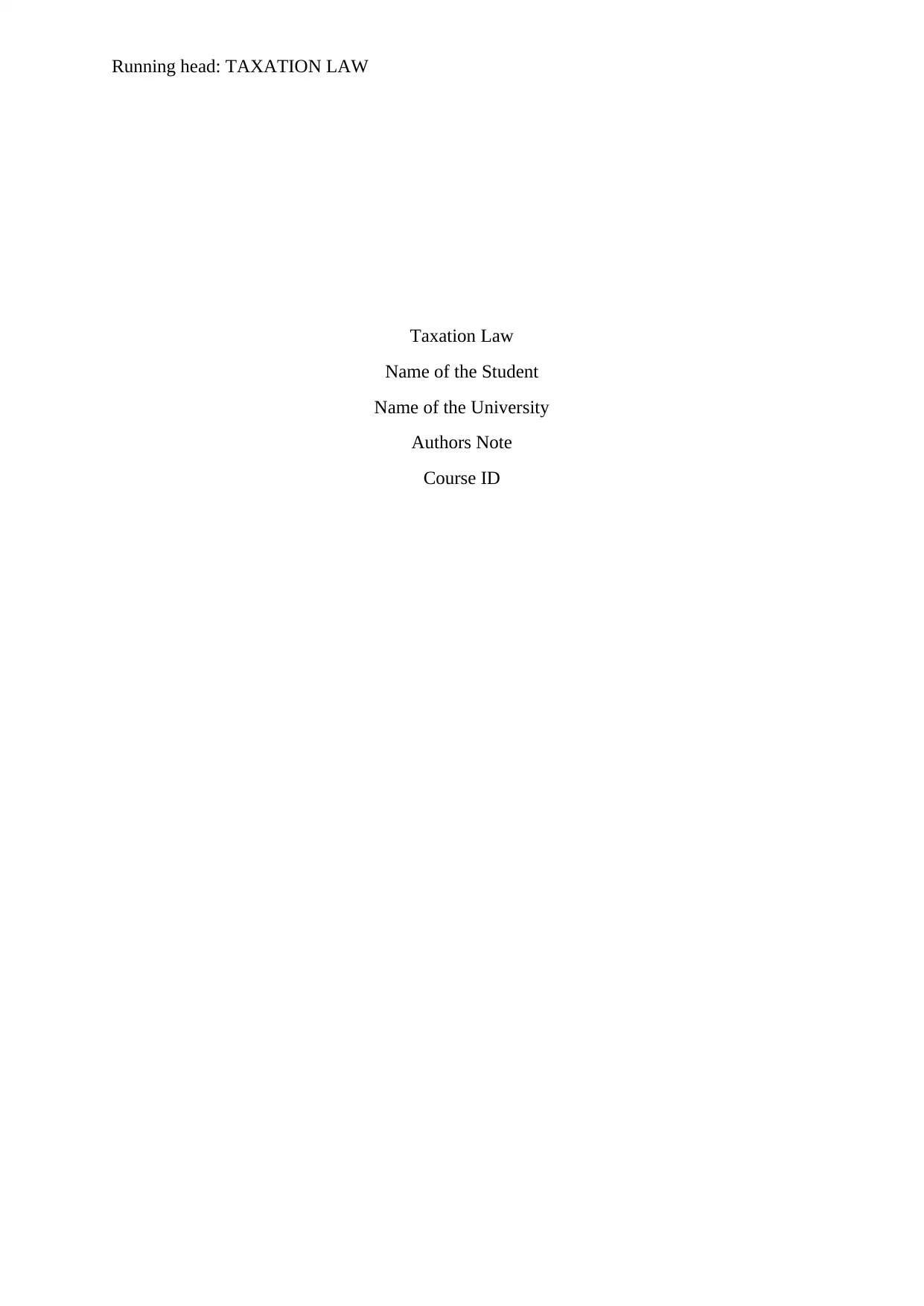
Running head: TAXATION LAW
Taxation Law
Name of the Student
Name of the University
Authors Note
Course ID
Taxation Law
Name of the Student
Name of the University
Authors Note
Course ID
Secure Best Marks with AI Grader
Need help grading? Try our AI Grader for instant feedback on your assignments.
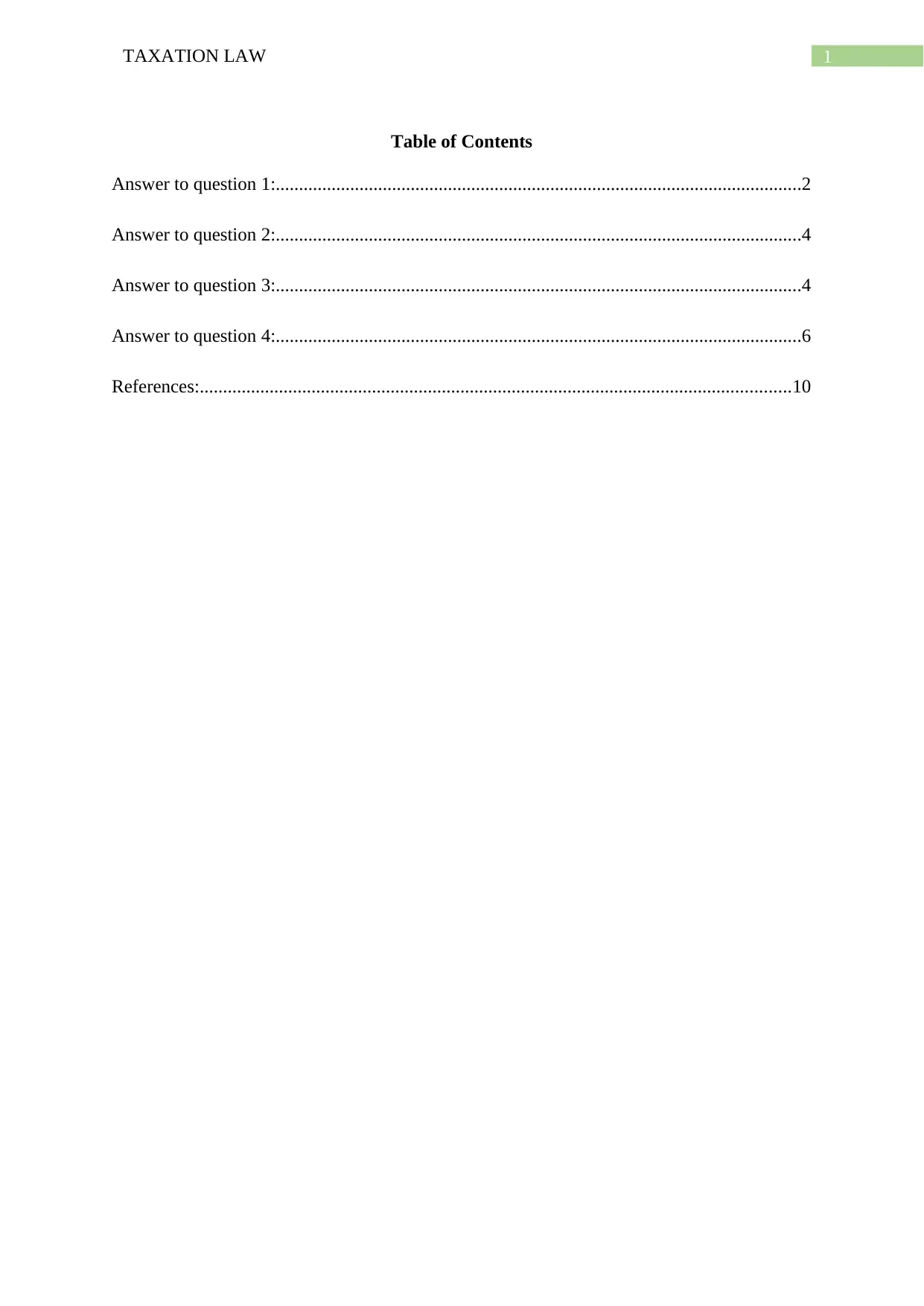
1TAXATION LAW
Table of Contents
Answer to question 1:.................................................................................................................2
Answer to question 2:.................................................................................................................4
Answer to question 3:.................................................................................................................4
Answer to question 4:.................................................................................................................6
References:...............................................................................................................................10
Table of Contents
Answer to question 1:.................................................................................................................2
Answer to question 2:.................................................................................................................4
Answer to question 3:.................................................................................................................4
Answer to question 4:.................................................................................................................6
References:...............................................................................................................................10
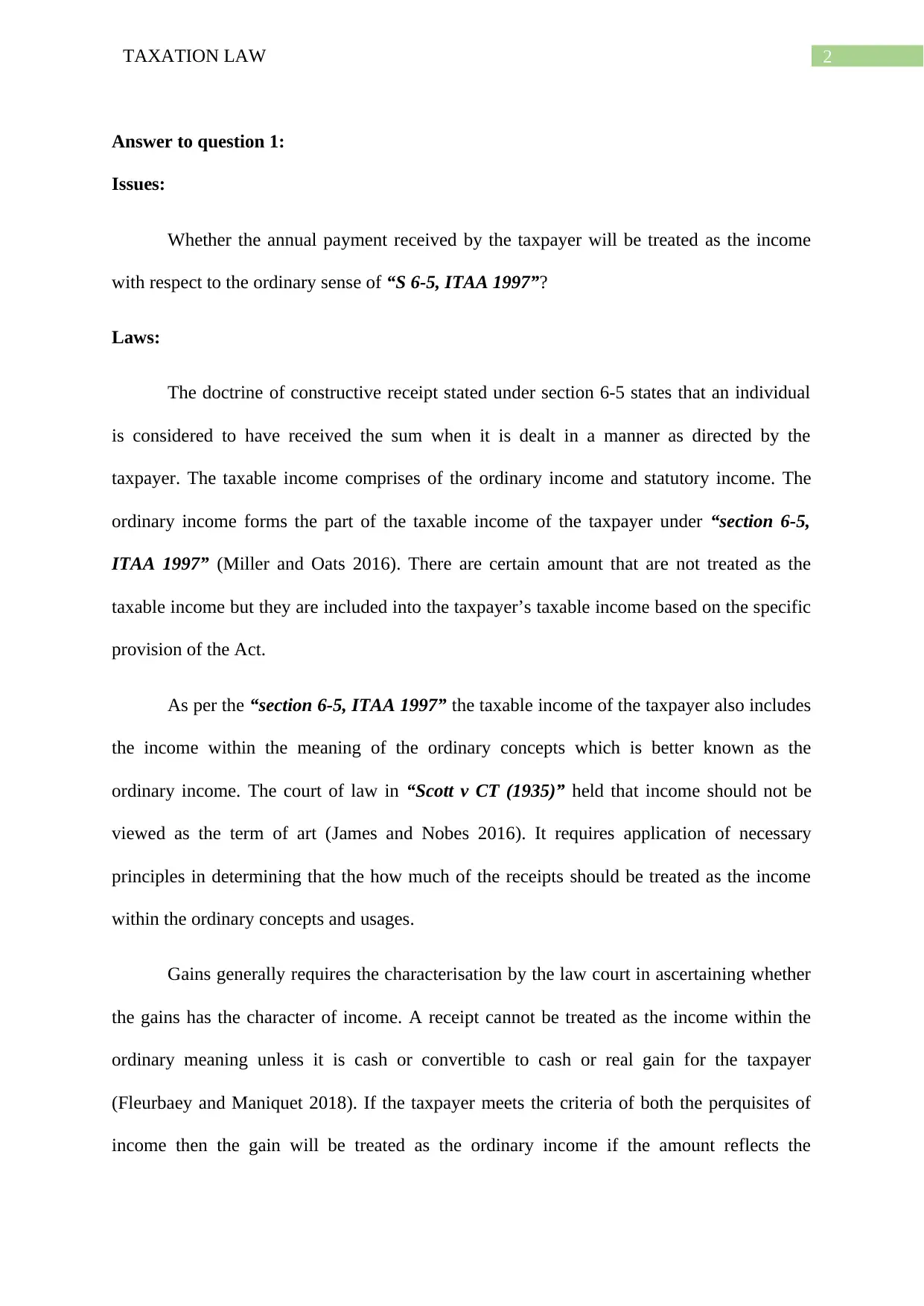
2TAXATION LAW
Answer to question 1:
Issues:
Whether the annual payment received by the taxpayer will be treated as the income
with respect to the ordinary sense of “S 6-5, ITAA 1997”?
Laws:
The doctrine of constructive receipt stated under section 6-5 states that an individual
is considered to have received the sum when it is dealt in a manner as directed by the
taxpayer. The taxable income comprises of the ordinary income and statutory income. The
ordinary income forms the part of the taxable income of the taxpayer under “section 6-5,
ITAA 1997” (Miller and Oats 2016). There are certain amount that are not treated as the
taxable income but they are included into the taxpayer’s taxable income based on the specific
provision of the Act.
As per the “section 6-5, ITAA 1997” the taxable income of the taxpayer also includes
the income within the meaning of the ordinary concepts which is better known as the
ordinary income. The court of law in “Scott v CT (1935)” held that income should not be
viewed as the term of art (James and Nobes 2016). It requires application of necessary
principles in determining that the how much of the receipts should be treated as the income
within the ordinary concepts and usages.
Gains generally requires the characterisation by the law court in ascertaining whether
the gains has the character of income. A receipt cannot be treated as the income within the
ordinary meaning unless it is cash or convertible to cash or real gain for the taxpayer
(Fleurbaey and Maniquet 2018). If the taxpayer meets the criteria of both the perquisites of
income then the gain will be treated as the ordinary income if the amount reflects the
Answer to question 1:
Issues:
Whether the annual payment received by the taxpayer will be treated as the income
with respect to the ordinary sense of “S 6-5, ITAA 1997”?
Laws:
The doctrine of constructive receipt stated under section 6-5 states that an individual
is considered to have received the sum when it is dealt in a manner as directed by the
taxpayer. The taxable income comprises of the ordinary income and statutory income. The
ordinary income forms the part of the taxable income of the taxpayer under “section 6-5,
ITAA 1997” (Miller and Oats 2016). There are certain amount that are not treated as the
taxable income but they are included into the taxpayer’s taxable income based on the specific
provision of the Act.
As per the “section 6-5, ITAA 1997” the taxable income of the taxpayer also includes
the income within the meaning of the ordinary concepts which is better known as the
ordinary income. The court of law in “Scott v CT (1935)” held that income should not be
viewed as the term of art (James and Nobes 2016). It requires application of necessary
principles in determining that the how much of the receipts should be treated as the income
within the ordinary concepts and usages.
Gains generally requires the characterisation by the law court in ascertaining whether
the gains has the character of income. A receipt cannot be treated as the income within the
ordinary meaning unless it is cash or convertible to cash or real gain for the taxpayer
(Fleurbaey and Maniquet 2018). If the taxpayer meets the criteria of both the perquisites of
income then the gain will be treated as the ordinary income if the amount reflects the
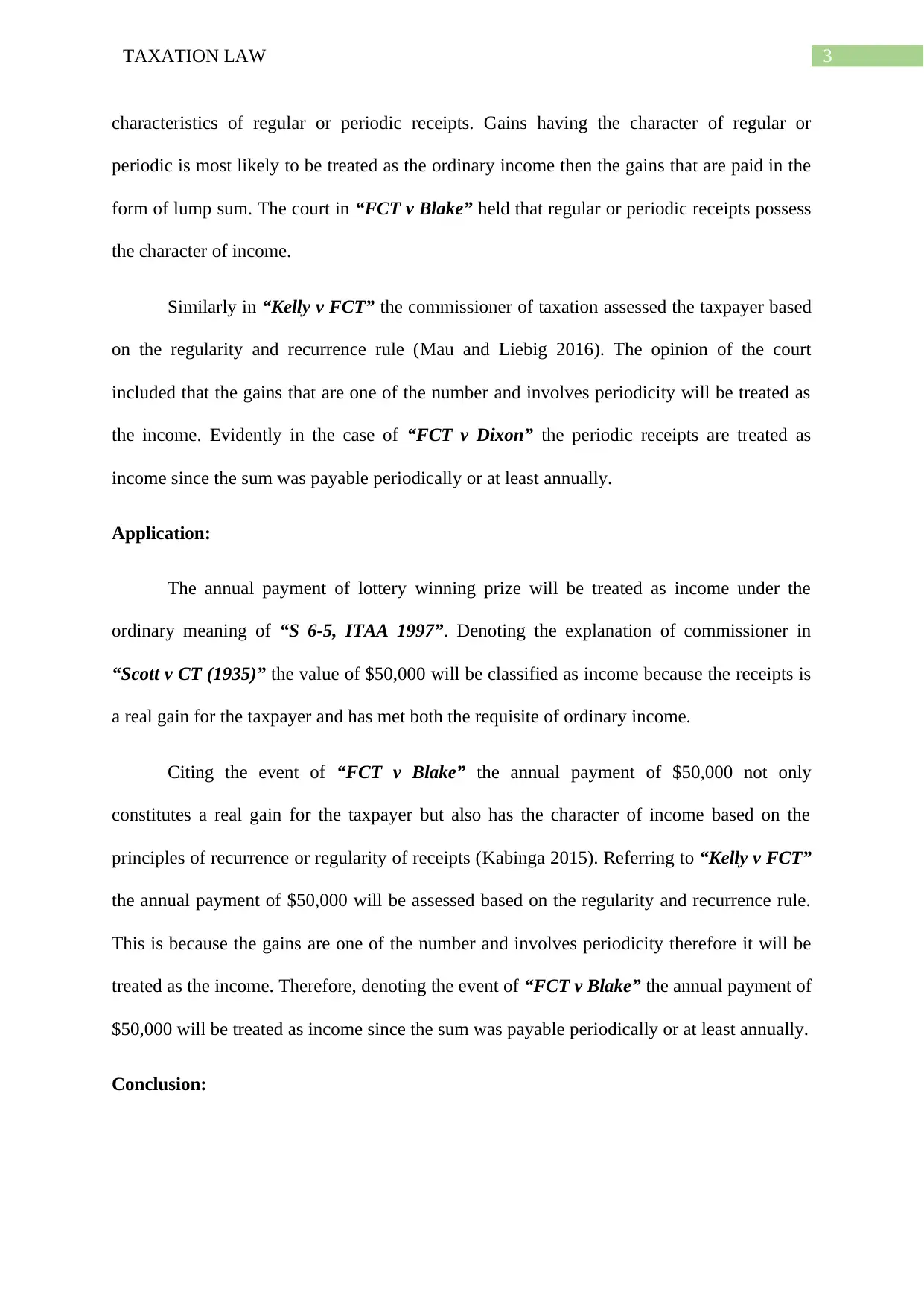
3TAXATION LAW
characteristics of regular or periodic receipts. Gains having the character of regular or
periodic is most likely to be treated as the ordinary income then the gains that are paid in the
form of lump sum. The court in “FCT v Blake” held that regular or periodic receipts possess
the character of income.
Similarly in “Kelly v FCT” the commissioner of taxation assessed the taxpayer based
on the regularity and recurrence rule (Mau and Liebig 2016). The opinion of the court
included that the gains that are one of the number and involves periodicity will be treated as
the income. Evidently in the case of “FCT v Dixon” the periodic receipts are treated as
income since the sum was payable periodically or at least annually.
Application:
The annual payment of lottery winning prize will be treated as income under the
ordinary meaning of “S 6-5, ITAA 1997”. Denoting the explanation of commissioner in
“Scott v CT (1935)” the value of $50,000 will be classified as income because the receipts is
a real gain for the taxpayer and has met both the requisite of ordinary income.
Citing the event of “FCT v Blake” the annual payment of $50,000 not only
constitutes a real gain for the taxpayer but also has the character of income based on the
principles of recurrence or regularity of receipts (Kabinga 2015). Referring to “Kelly v FCT”
the annual payment of $50,000 will be assessed based on the regularity and recurrence rule.
This is because the gains are one of the number and involves periodicity therefore it will be
treated as the income. Therefore, denoting the event of “FCT v Blake” the annual payment of
$50,000 will be treated as income since the sum was payable periodically or at least annually.
Conclusion:
characteristics of regular or periodic receipts. Gains having the character of regular or
periodic is most likely to be treated as the ordinary income then the gains that are paid in the
form of lump sum. The court in “FCT v Blake” held that regular or periodic receipts possess
the character of income.
Similarly in “Kelly v FCT” the commissioner of taxation assessed the taxpayer based
on the regularity and recurrence rule (Mau and Liebig 2016). The opinion of the court
included that the gains that are one of the number and involves periodicity will be treated as
the income. Evidently in the case of “FCT v Dixon” the periodic receipts are treated as
income since the sum was payable periodically or at least annually.
Application:
The annual payment of lottery winning prize will be treated as income under the
ordinary meaning of “S 6-5, ITAA 1997”. Denoting the explanation of commissioner in
“Scott v CT (1935)” the value of $50,000 will be classified as income because the receipts is
a real gain for the taxpayer and has met both the requisite of ordinary income.
Citing the event of “FCT v Blake” the annual payment of $50,000 not only
constitutes a real gain for the taxpayer but also has the character of income based on the
principles of recurrence or regularity of receipts (Kabinga 2015). Referring to “Kelly v FCT”
the annual payment of $50,000 will be assessed based on the regularity and recurrence rule.
This is because the gains are one of the number and involves periodicity therefore it will be
treated as the income. Therefore, denoting the event of “FCT v Blake” the annual payment of
$50,000 will be treated as income since the sum was payable periodically or at least annually.
Conclusion:
Secure Best Marks with AI Grader
Need help grading? Try our AI Grader for instant feedback on your assignments.
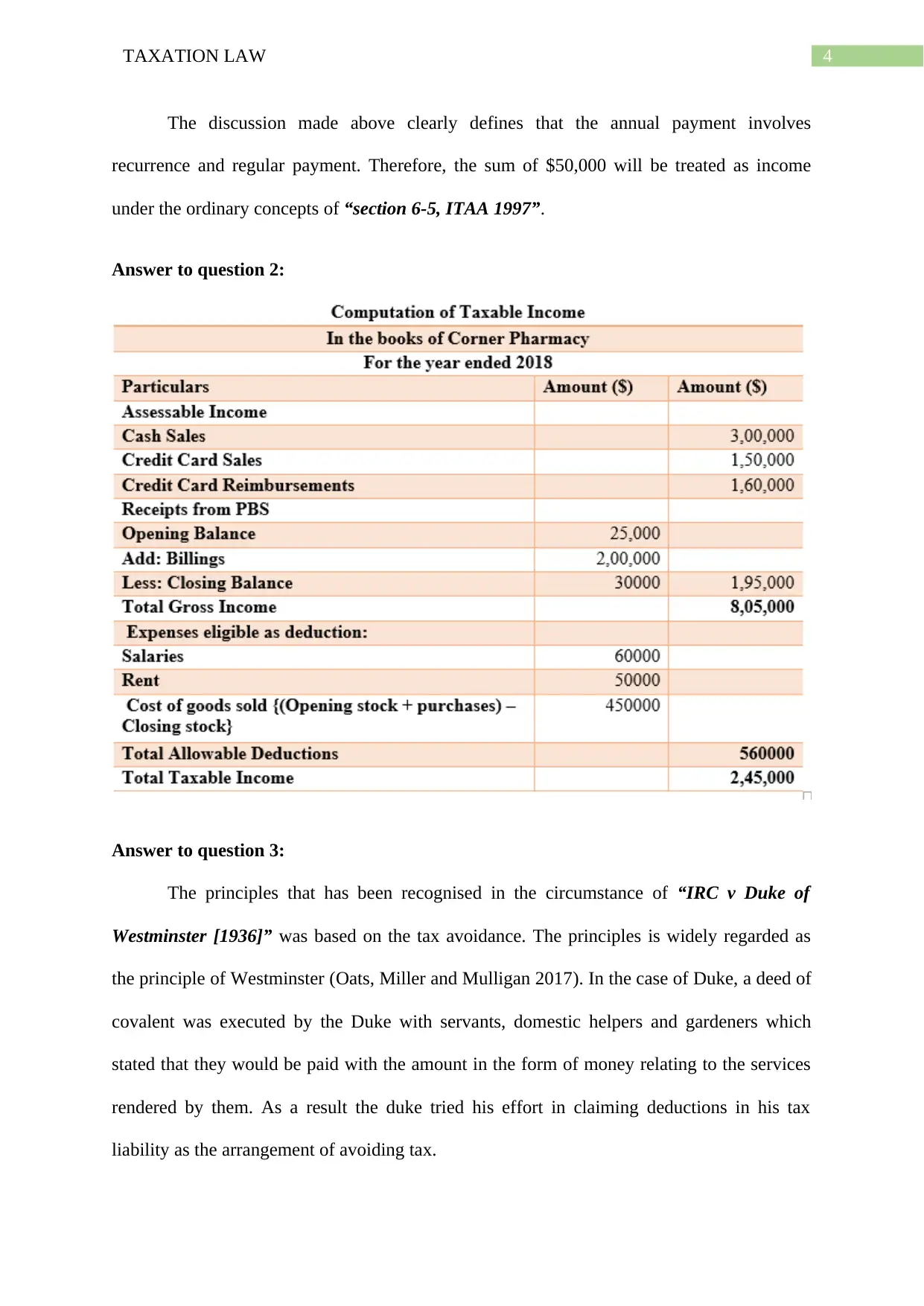
4TAXATION LAW
The discussion made above clearly defines that the annual payment involves
recurrence and regular payment. Therefore, the sum of $50,000 will be treated as income
under the ordinary concepts of “section 6-5, ITAA 1997”.
Answer to question 2:
Answer to question 3:
The principles that has been recognised in the circumstance of “IRC v Duke of
Westminster [1936]” was based on the tax avoidance. The principles is widely regarded as
the principle of Westminster (Oats, Miller and Mulligan 2017). In the case of Duke, a deed of
covalent was executed by the Duke with servants, domestic helpers and gardeners which
stated that they would be paid with the amount in the form of money relating to the services
rendered by them. As a result the duke tried his effort in claiming deductions in his tax
liability as the arrangement of avoiding tax.
The discussion made above clearly defines that the annual payment involves
recurrence and regular payment. Therefore, the sum of $50,000 will be treated as income
under the ordinary concepts of “section 6-5, ITAA 1997”.
Answer to question 2:
Answer to question 3:
The principles that has been recognised in the circumstance of “IRC v Duke of
Westminster [1936]” was based on the tax avoidance. The principles is widely regarded as
the principle of Westminster (Oats, Miller and Mulligan 2017). In the case of Duke, a deed of
covalent was executed by the Duke with servants, domestic helpers and gardeners which
stated that they would be paid with the amount in the form of money relating to the services
rendered by them. As a result the duke tried his effort in claiming deductions in his tax
liability as the arrangement of avoiding tax.
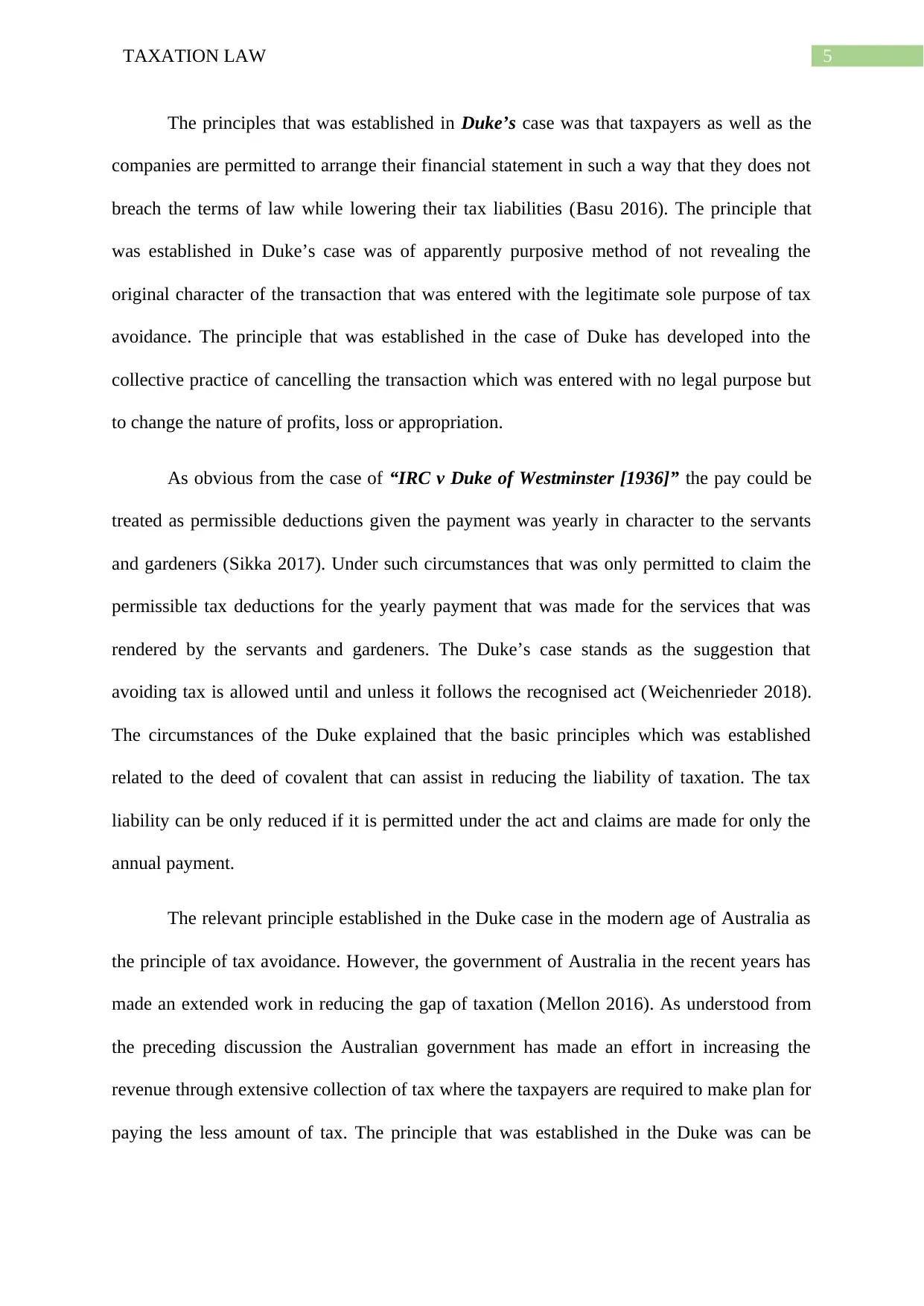
5TAXATION LAW
The principles that was established in Duke’s case was that taxpayers as well as the
companies are permitted to arrange their financial statement in such a way that they does not
breach the terms of law while lowering their tax liabilities (Basu 2016). The principle that
was established in Duke’s case was of apparently purposive method of not revealing the
original character of the transaction that was entered with the legitimate sole purpose of tax
avoidance. The principle that was established in the case of Duke has developed into the
collective practice of cancelling the transaction which was entered with no legal purpose but
to change the nature of profits, loss or appropriation.
As obvious from the case of “IRC v Duke of Westminster [1936]” the pay could be
treated as permissible deductions given the payment was yearly in character to the servants
and gardeners (Sikka 2017). Under such circumstances that was only permitted to claim the
permissible tax deductions for the yearly payment that was made for the services that was
rendered by the servants and gardeners. The Duke’s case stands as the suggestion that
avoiding tax is allowed until and unless it follows the recognised act (Weichenrieder 2018).
The circumstances of the Duke explained that the basic principles which was established
related to the deed of covalent that can assist in reducing the liability of taxation. The tax
liability can be only reduced if it is permitted under the act and claims are made for only the
annual payment.
The relevant principle established in the Duke case in the modern age of Australia as
the principle of tax avoidance. However, the government of Australia in the recent years has
made an extended work in reducing the gap of taxation (Mellon 2016). As understood from
the preceding discussion the Australian government has made an effort in increasing the
revenue through extensive collection of tax where the taxpayers are required to make plan for
paying the less amount of tax. The principle that was established in the Duke was can be
The principles that was established in Duke’s case was that taxpayers as well as the
companies are permitted to arrange their financial statement in such a way that they does not
breach the terms of law while lowering their tax liabilities (Basu 2016). The principle that
was established in Duke’s case was of apparently purposive method of not revealing the
original character of the transaction that was entered with the legitimate sole purpose of tax
avoidance. The principle that was established in the case of Duke has developed into the
collective practice of cancelling the transaction which was entered with no legal purpose but
to change the nature of profits, loss or appropriation.
As obvious from the case of “IRC v Duke of Westminster [1936]” the pay could be
treated as permissible deductions given the payment was yearly in character to the servants
and gardeners (Sikka 2017). Under such circumstances that was only permitted to claim the
permissible tax deductions for the yearly payment that was made for the services that was
rendered by the servants and gardeners. The Duke’s case stands as the suggestion that
avoiding tax is allowed until and unless it follows the recognised act (Weichenrieder 2018).
The circumstances of the Duke explained that the basic principles which was established
related to the deed of covalent that can assist in reducing the liability of taxation. The tax
liability can be only reduced if it is permitted under the act and claims are made for only the
annual payment.
The relevant principle established in the Duke case in the modern age of Australia as
the principle of tax avoidance. However, the government of Australia in the recent years has
made an extended work in reducing the gap of taxation (Mellon 2016). As understood from
the preceding discussion the Australian government has made an effort in increasing the
revenue through extensive collection of tax where the taxpayers are required to make plan for
paying the less amount of tax. The principle that was established in the Duke was can be
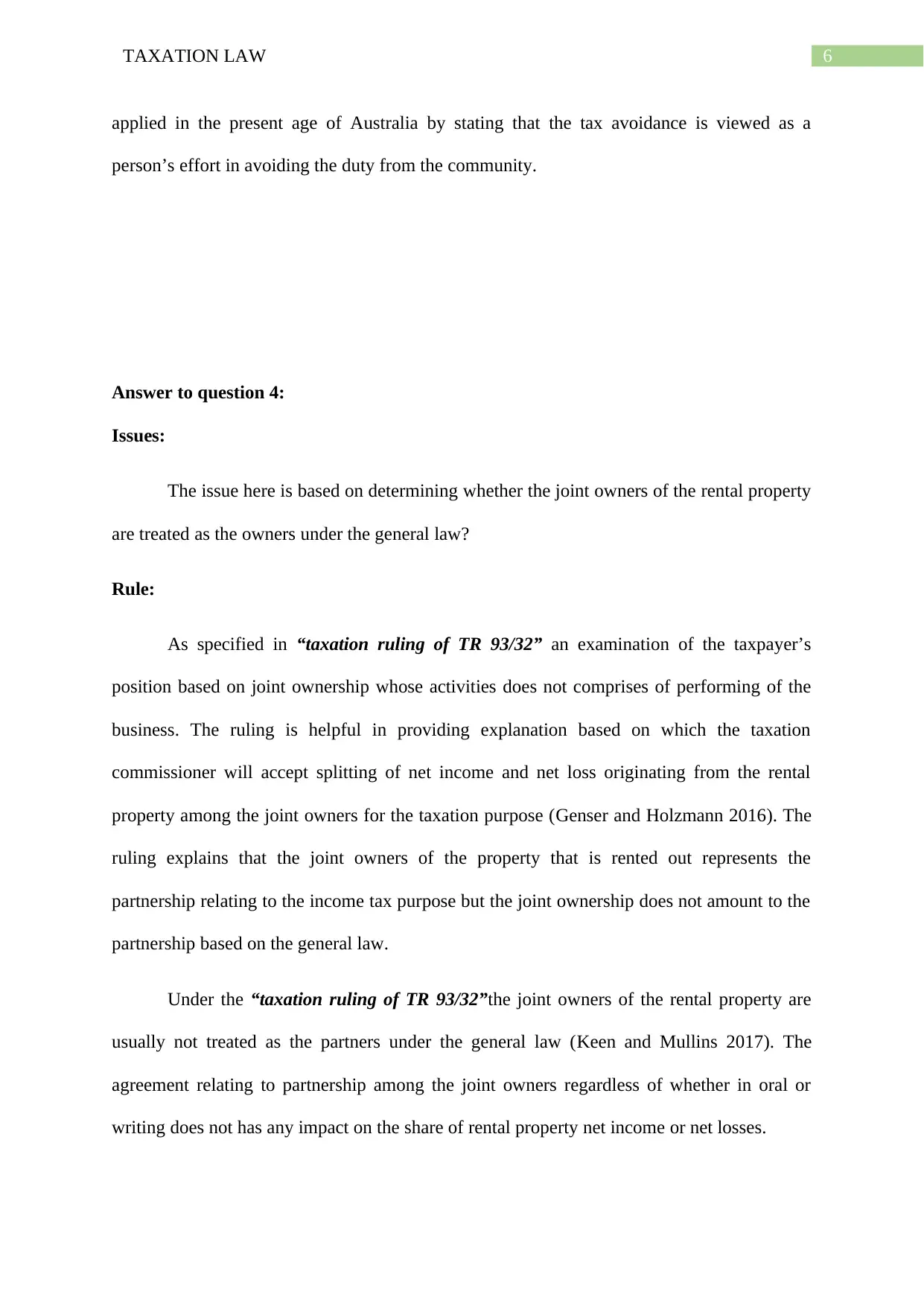
6TAXATION LAW
applied in the present age of Australia by stating that the tax avoidance is viewed as a
person’s effort in avoiding the duty from the community.
Answer to question 4:
Issues:
The issue here is based on determining whether the joint owners of the rental property
are treated as the owners under the general law?
Rule:
As specified in “taxation ruling of TR 93/32” an examination of the taxpayer’s
position based on joint ownership whose activities does not comprises of performing of the
business. The ruling is helpful in providing explanation based on which the taxation
commissioner will accept splitting of net income and net loss originating from the rental
property among the joint owners for the taxation purpose (Genser and Holzmann 2016). The
ruling explains that the joint owners of the property that is rented out represents the
partnership relating to the income tax purpose but the joint ownership does not amount to the
partnership based on the general law.
Under the “taxation ruling of TR 93/32”the joint owners of the rental property are
usually not treated as the partners under the general law (Keen and Mullins 2017). The
agreement relating to partnership among the joint owners regardless of whether in oral or
writing does not has any impact on the share of rental property net income or net losses.
applied in the present age of Australia by stating that the tax avoidance is viewed as a
person’s effort in avoiding the duty from the community.
Answer to question 4:
Issues:
The issue here is based on determining whether the joint owners of the rental property
are treated as the owners under the general law?
Rule:
As specified in “taxation ruling of TR 93/32” an examination of the taxpayer’s
position based on joint ownership whose activities does not comprises of performing of the
business. The ruling is helpful in providing explanation based on which the taxation
commissioner will accept splitting of net income and net loss originating from the rental
property among the joint owners for the taxation purpose (Genser and Holzmann 2016). The
ruling explains that the joint owners of the property that is rented out represents the
partnership relating to the income tax purpose but the joint ownership does not amount to the
partnership based on the general law.
Under the “taxation ruling of TR 93/32”the joint owners of the rental property are
usually not treated as the partners under the general law (Keen and Mullins 2017). The
agreement relating to partnership among the joint owners regardless of whether in oral or
writing does not has any impact on the share of rental property net income or net losses.
Paraphrase This Document
Need a fresh take? Get an instant paraphrase of this document with our AI Paraphraser
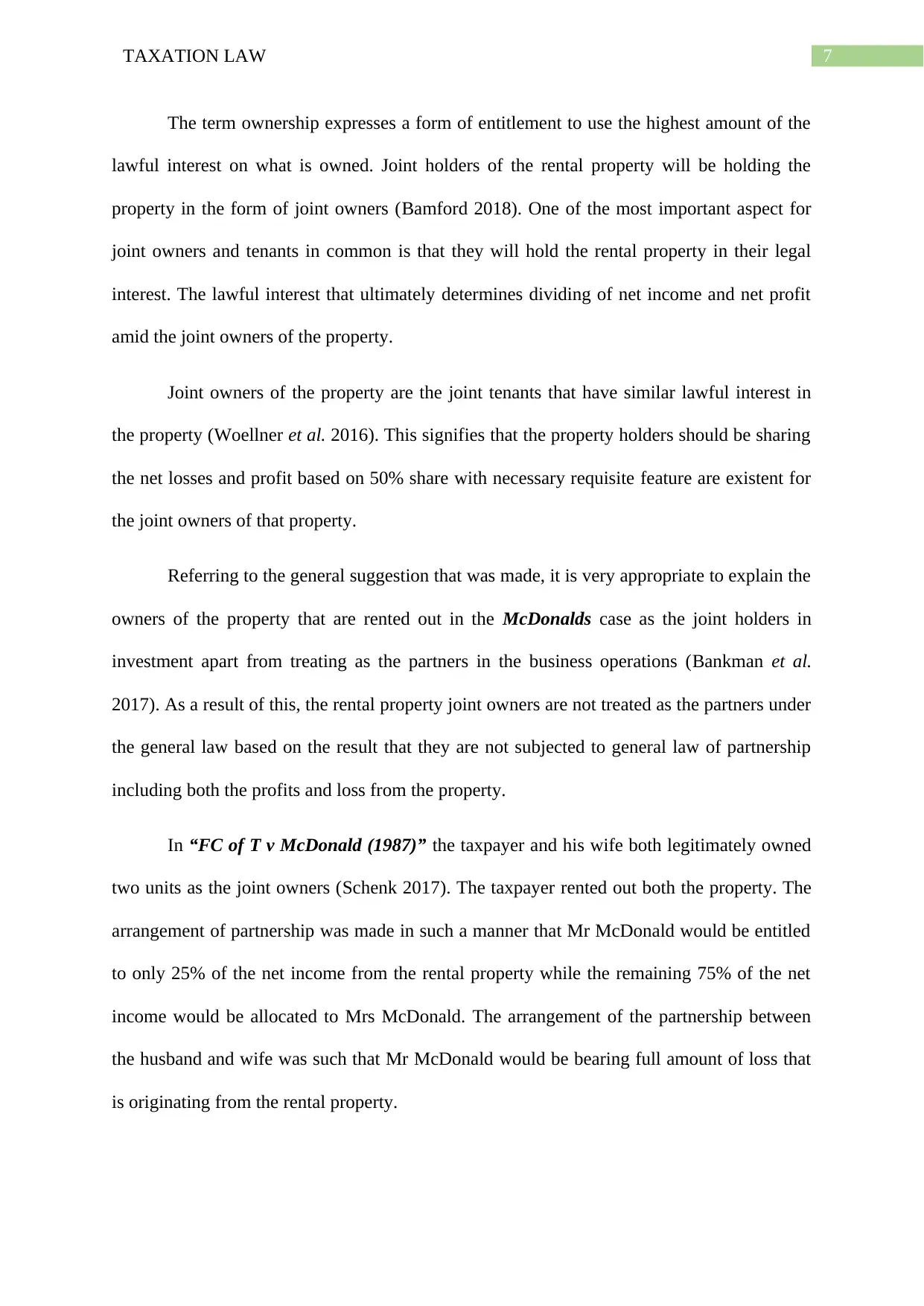
7TAXATION LAW
The term ownership expresses a form of entitlement to use the highest amount of the
lawful interest on what is owned. Joint holders of the rental property will be holding the
property in the form of joint owners (Bamford 2018). One of the most important aspect for
joint owners and tenants in common is that they will hold the rental property in their legal
interest. The lawful interest that ultimately determines dividing of net income and net profit
amid the joint owners of the property.
Joint owners of the property are the joint tenants that have similar lawful interest in
the property (Woellner et al. 2016). This signifies that the property holders should be sharing
the net losses and profit based on 50% share with necessary requisite feature are existent for
the joint owners of that property.
Referring to the general suggestion that was made, it is very appropriate to explain the
owners of the property that are rented out in the McDonalds case as the joint holders in
investment apart from treating as the partners in the business operations (Bankman et al.
2017). As a result of this, the rental property joint owners are not treated as the partners under
the general law based on the result that they are not subjected to general law of partnership
including both the profits and loss from the property.
In “FC of T v McDonald (1987)” the taxpayer and his wife both legitimately owned
two units as the joint owners (Schenk 2017). The taxpayer rented out both the property. The
arrangement of partnership was made in such a manner that Mr McDonald would be entitled
to only 25% of the net income from the rental property while the remaining 75% of the net
income would be allocated to Mrs McDonald. The arrangement of the partnership between
the husband and wife was such that Mr McDonald would be bearing full amount of loss that
is originating from the rental property.
The term ownership expresses a form of entitlement to use the highest amount of the
lawful interest on what is owned. Joint holders of the rental property will be holding the
property in the form of joint owners (Bamford 2018). One of the most important aspect for
joint owners and tenants in common is that they will hold the rental property in their legal
interest. The lawful interest that ultimately determines dividing of net income and net profit
amid the joint owners of the property.
Joint owners of the property are the joint tenants that have similar lawful interest in
the property (Woellner et al. 2016). This signifies that the property holders should be sharing
the net losses and profit based on 50% share with necessary requisite feature are existent for
the joint owners of that property.
Referring to the general suggestion that was made, it is very appropriate to explain the
owners of the property that are rented out in the McDonalds case as the joint holders in
investment apart from treating as the partners in the business operations (Bankman et al.
2017). As a result of this, the rental property joint owners are not treated as the partners under
the general law based on the result that they are not subjected to general law of partnership
including both the profits and loss from the property.
In “FC of T v McDonald (1987)” the taxpayer and his wife both legitimately owned
two units as the joint owners (Schenk 2017). The taxpayer rented out both the property. The
arrangement of partnership was made in such a manner that Mr McDonald would be entitled
to only 25% of the net income from the rental property while the remaining 75% of the net
income would be allocated to Mrs McDonald. The arrangement of the partnership between
the husband and wife was such that Mr McDonald would be bearing full amount of loss that
is originating from the rental property.
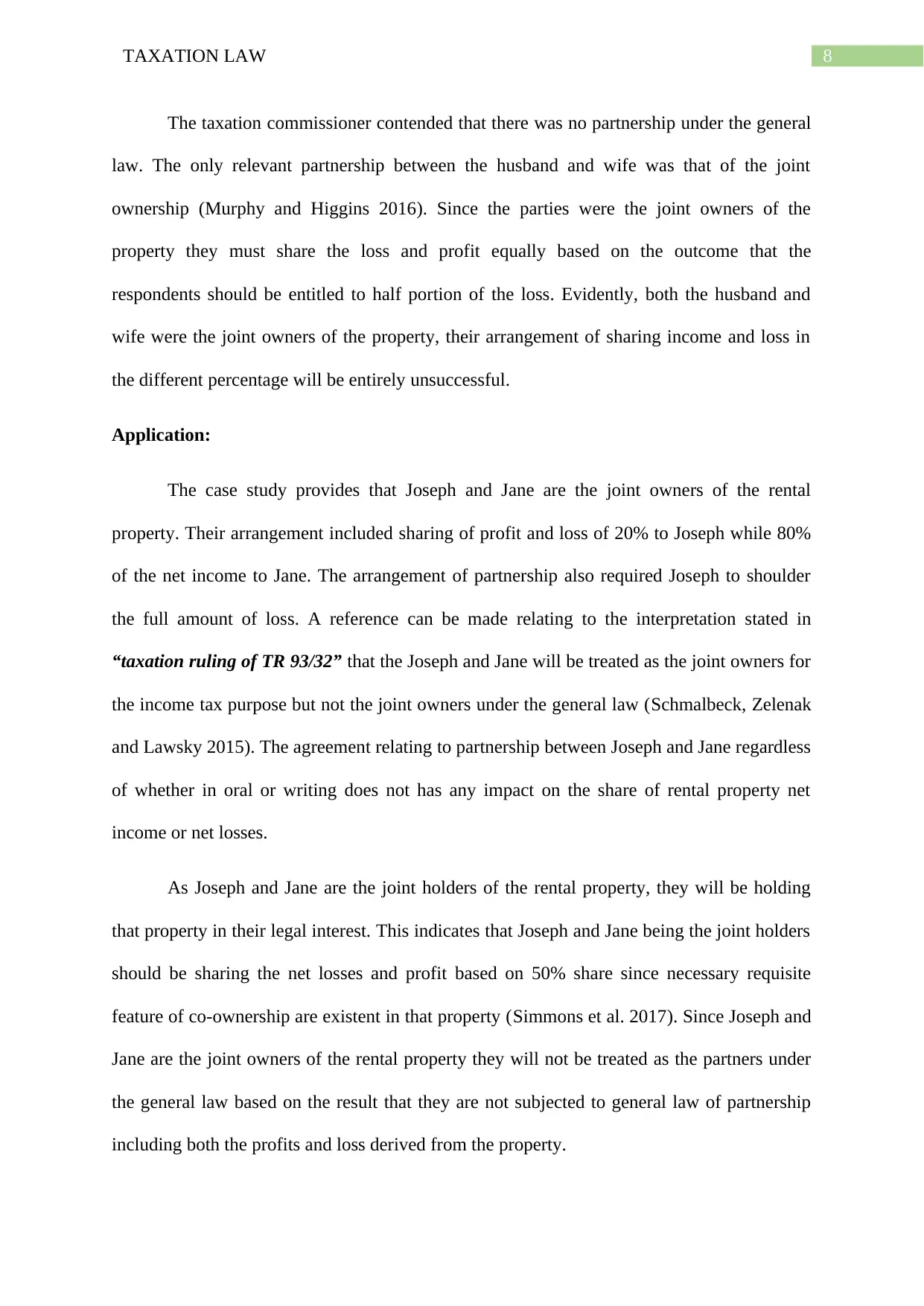
8TAXATION LAW
The taxation commissioner contended that there was no partnership under the general
law. The only relevant partnership between the husband and wife was that of the joint
ownership (Murphy and Higgins 2016). Since the parties were the joint owners of the
property they must share the loss and profit equally based on the outcome that the
respondents should be entitled to half portion of the loss. Evidently, both the husband and
wife were the joint owners of the property, their arrangement of sharing income and loss in
the different percentage will be entirely unsuccessful.
Application:
The case study provides that Joseph and Jane are the joint owners of the rental
property. Their arrangement included sharing of profit and loss of 20% to Joseph while 80%
of the net income to Jane. The arrangement of partnership also required Joseph to shoulder
the full amount of loss. A reference can be made relating to the interpretation stated in
“taxation ruling of TR 93/32” that the Joseph and Jane will be treated as the joint owners for
the income tax purpose but not the joint owners under the general law (Schmalbeck, Zelenak
and Lawsky 2015). The agreement relating to partnership between Joseph and Jane regardless
of whether in oral or writing does not has any impact on the share of rental property net
income or net losses.
As Joseph and Jane are the joint holders of the rental property, they will be holding
that property in their legal interest. This indicates that Joseph and Jane being the joint holders
should be sharing the net losses and profit based on 50% share since necessary requisite
feature of co-ownership are existent in that property (Simmons et al. 2017). Since Joseph and
Jane are the joint owners of the rental property they will not be treated as the partners under
the general law based on the result that they are not subjected to general law of partnership
including both the profits and loss derived from the property.
The taxation commissioner contended that there was no partnership under the general
law. The only relevant partnership between the husband and wife was that of the joint
ownership (Murphy and Higgins 2016). Since the parties were the joint owners of the
property they must share the loss and profit equally based on the outcome that the
respondents should be entitled to half portion of the loss. Evidently, both the husband and
wife were the joint owners of the property, their arrangement of sharing income and loss in
the different percentage will be entirely unsuccessful.
Application:
The case study provides that Joseph and Jane are the joint owners of the rental
property. Their arrangement included sharing of profit and loss of 20% to Joseph while 80%
of the net income to Jane. The arrangement of partnership also required Joseph to shoulder
the full amount of loss. A reference can be made relating to the interpretation stated in
“taxation ruling of TR 93/32” that the Joseph and Jane will be treated as the joint owners for
the income tax purpose but not the joint owners under the general law (Schmalbeck, Zelenak
and Lawsky 2015). The agreement relating to partnership between Joseph and Jane regardless
of whether in oral or writing does not has any impact on the share of rental property net
income or net losses.
As Joseph and Jane are the joint holders of the rental property, they will be holding
that property in their legal interest. This indicates that Joseph and Jane being the joint holders
should be sharing the net losses and profit based on 50% share since necessary requisite
feature of co-ownership are existent in that property (Simmons et al. 2017). Since Joseph and
Jane are the joint owners of the rental property they will not be treated as the partners under
the general law based on the result that they are not subjected to general law of partnership
including both the profits and loss derived from the property.
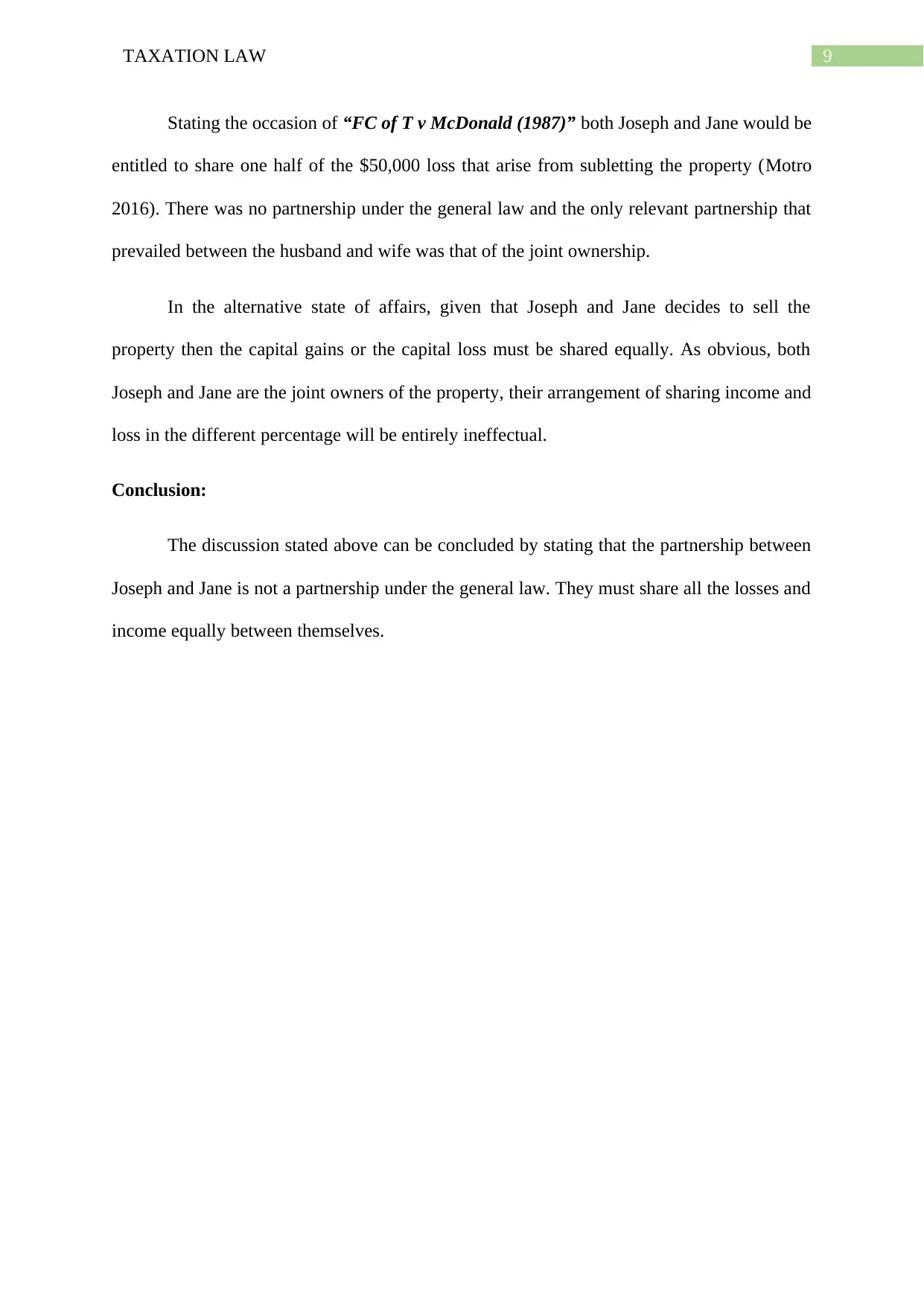
9TAXATION LAW
Stating the occasion of “FC of T v McDonald (1987)” both Joseph and Jane would be
entitled to share one half of the $50,000 loss that arise from subletting the property (Motro
2016). There was no partnership under the general law and the only relevant partnership that
prevailed between the husband and wife was that of the joint ownership.
In the alternative state of affairs, given that Joseph and Jane decides to sell the
property then the capital gains or the capital loss must be shared equally. As obvious, both
Joseph and Jane are the joint owners of the property, their arrangement of sharing income and
loss in the different percentage will be entirely ineffectual.
Conclusion:
The discussion stated above can be concluded by stating that the partnership between
Joseph and Jane is not a partnership under the general law. They must share all the losses and
income equally between themselves.
Stating the occasion of “FC of T v McDonald (1987)” both Joseph and Jane would be
entitled to share one half of the $50,000 loss that arise from subletting the property (Motro
2016). There was no partnership under the general law and the only relevant partnership that
prevailed between the husband and wife was that of the joint ownership.
In the alternative state of affairs, given that Joseph and Jane decides to sell the
property then the capital gains or the capital loss must be shared equally. As obvious, both
Joseph and Jane are the joint owners of the property, their arrangement of sharing income and
loss in the different percentage will be entirely ineffectual.
Conclusion:
The discussion stated above can be concluded by stating that the partnership between
Joseph and Jane is not a partnership under the general law. They must share all the losses and
income equally between themselves.
Secure Best Marks with AI Grader
Need help grading? Try our AI Grader for instant feedback on your assignments.
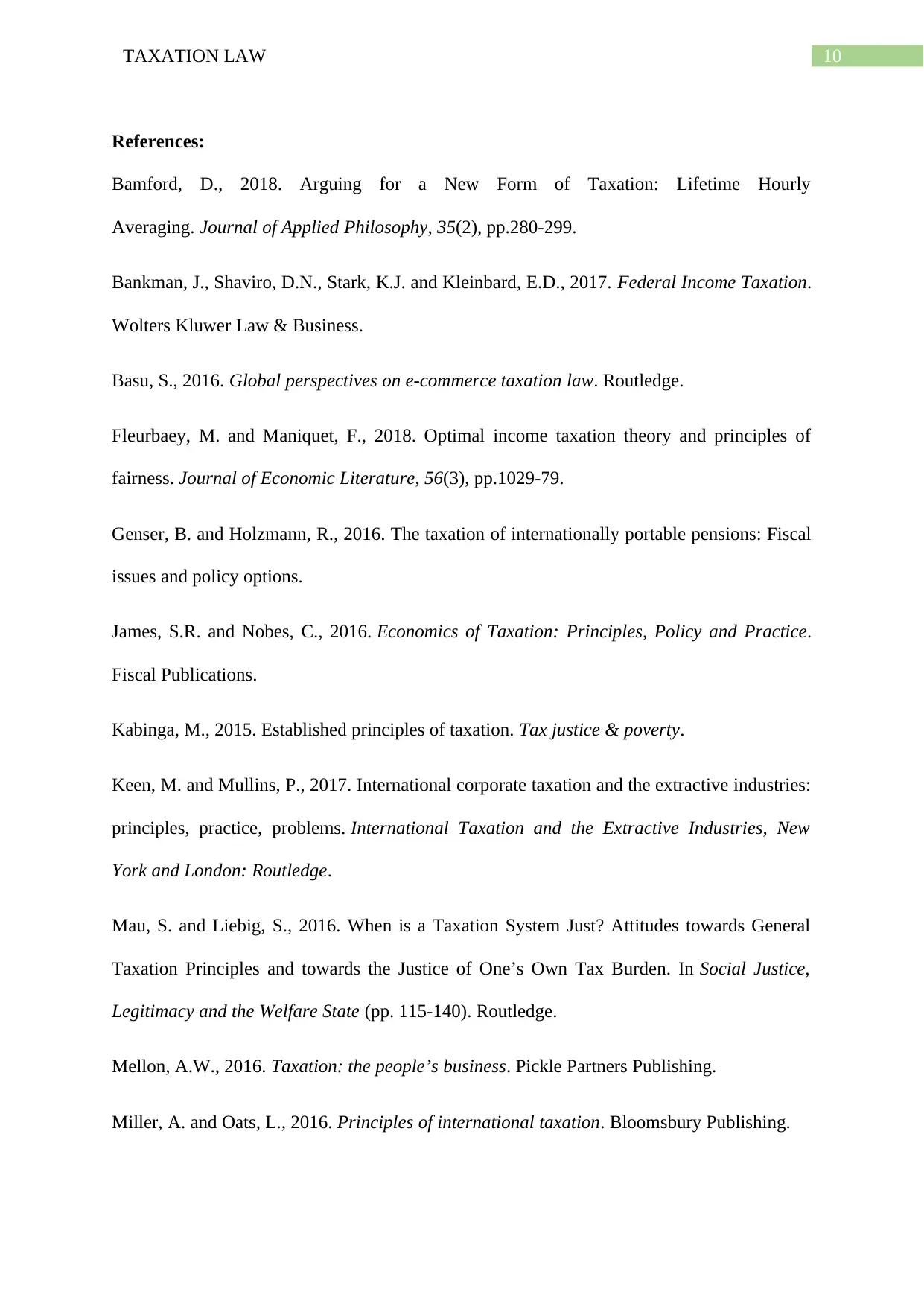
10TAXATION LAW
References:
Bamford, D., 2018. Arguing for a New Form of Taxation: Lifetime Hourly
Averaging. Journal of Applied Philosophy, 35(2), pp.280-299.
Bankman, J., Shaviro, D.N., Stark, K.J. and Kleinbard, E.D., 2017. Federal Income Taxation.
Wolters Kluwer Law & Business.
Basu, S., 2016. Global perspectives on e-commerce taxation law. Routledge.
Fleurbaey, M. and Maniquet, F., 2018. Optimal income taxation theory and principles of
fairness. Journal of Economic Literature, 56(3), pp.1029-79.
Genser, B. and Holzmann, R., 2016. The taxation of internationally portable pensions: Fiscal
issues and policy options.
James, S.R. and Nobes, C., 2016. Economics of Taxation: Principles, Policy and Practice.
Fiscal Publications.
Kabinga, M., 2015. Established principles of taxation. Tax justice & poverty.
Keen, M. and Mullins, P., 2017. International corporate taxation and the extractive industries:
principles, practice, problems. International Taxation and the Extractive Industries, New
York and London: Routledge.
Mau, S. and Liebig, S., 2016. When is a Taxation System Just? Attitudes towards General
Taxation Principles and towards the Justice of One’s Own Tax Burden. In Social Justice,
Legitimacy and the Welfare State (pp. 115-140). Routledge.
Mellon, A.W., 2016. Taxation: the people’s business. Pickle Partners Publishing.
Miller, A. and Oats, L., 2016. Principles of international taxation. Bloomsbury Publishing.
References:
Bamford, D., 2018. Arguing for a New Form of Taxation: Lifetime Hourly
Averaging. Journal of Applied Philosophy, 35(2), pp.280-299.
Bankman, J., Shaviro, D.N., Stark, K.J. and Kleinbard, E.D., 2017. Federal Income Taxation.
Wolters Kluwer Law & Business.
Basu, S., 2016. Global perspectives on e-commerce taxation law. Routledge.
Fleurbaey, M. and Maniquet, F., 2018. Optimal income taxation theory and principles of
fairness. Journal of Economic Literature, 56(3), pp.1029-79.
Genser, B. and Holzmann, R., 2016. The taxation of internationally portable pensions: Fiscal
issues and policy options.
James, S.R. and Nobes, C., 2016. Economics of Taxation: Principles, Policy and Practice.
Fiscal Publications.
Kabinga, M., 2015. Established principles of taxation. Tax justice & poverty.
Keen, M. and Mullins, P., 2017. International corporate taxation and the extractive industries:
principles, practice, problems. International Taxation and the Extractive Industries, New
York and London: Routledge.
Mau, S. and Liebig, S., 2016. When is a Taxation System Just? Attitudes towards General
Taxation Principles and towards the Justice of One’s Own Tax Burden. In Social Justice,
Legitimacy and the Welfare State (pp. 115-140). Routledge.
Mellon, A.W., 2016. Taxation: the people’s business. Pickle Partners Publishing.
Miller, A. and Oats, L., 2016. Principles of international taxation. Bloomsbury Publishing.
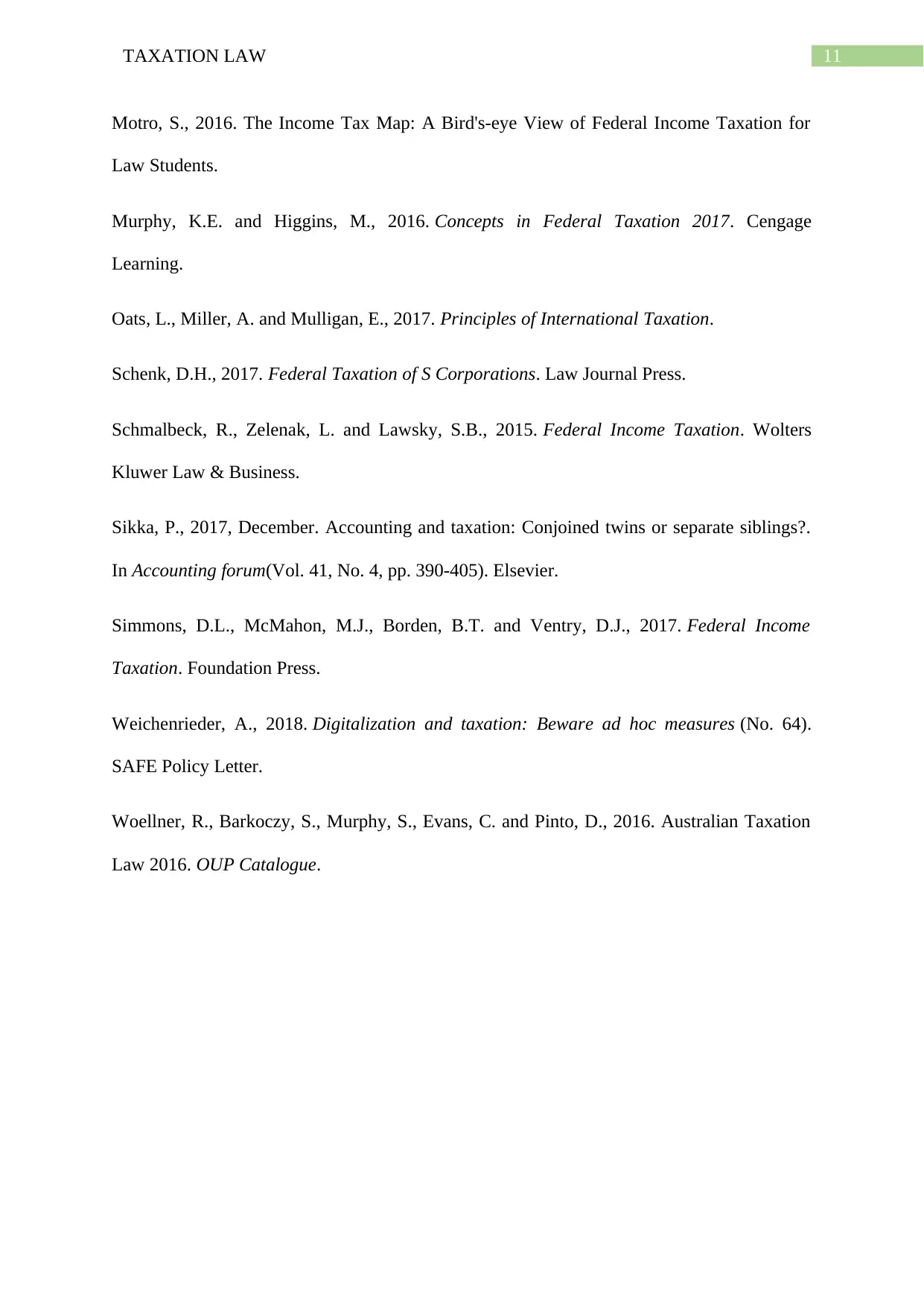
11TAXATION LAW
Motro, S., 2016. The Income Tax Map: A Bird's-eye View of Federal Income Taxation for
Law Students.
Murphy, K.E. and Higgins, M., 2016. Concepts in Federal Taxation 2017. Cengage
Learning.
Oats, L., Miller, A. and Mulligan, E., 2017. Principles of International Taxation.
Schenk, D.H., 2017. Federal Taxation of S Corporations. Law Journal Press.
Schmalbeck, R., Zelenak, L. and Lawsky, S.B., 2015. Federal Income Taxation. Wolters
Kluwer Law & Business.
Sikka, P., 2017, December. Accounting and taxation: Conjoined twins or separate siblings?.
In Accounting forum(Vol. 41, No. 4, pp. 390-405). Elsevier.
Simmons, D.L., McMahon, M.J., Borden, B.T. and Ventry, D.J., 2017. Federal Income
Taxation. Foundation Press.
Weichenrieder, A., 2018. Digitalization and taxation: Beware ad hoc measures (No. 64).
SAFE Policy Letter.
Woellner, R., Barkoczy, S., Murphy, S., Evans, C. and Pinto, D., 2016. Australian Taxation
Law 2016. OUP Catalogue.
Motro, S., 2016. The Income Tax Map: A Bird's-eye View of Federal Income Taxation for
Law Students.
Murphy, K.E. and Higgins, M., 2016. Concepts in Federal Taxation 2017. Cengage
Learning.
Oats, L., Miller, A. and Mulligan, E., 2017. Principles of International Taxation.
Schenk, D.H., 2017. Federal Taxation of S Corporations. Law Journal Press.
Schmalbeck, R., Zelenak, L. and Lawsky, S.B., 2015. Federal Income Taxation. Wolters
Kluwer Law & Business.
Sikka, P., 2017, December. Accounting and taxation: Conjoined twins or separate siblings?.
In Accounting forum(Vol. 41, No. 4, pp. 390-405). Elsevier.
Simmons, D.L., McMahon, M.J., Borden, B.T. and Ventry, D.J., 2017. Federal Income
Taxation. Foundation Press.
Weichenrieder, A., 2018. Digitalization and taxation: Beware ad hoc measures (No. 64).
SAFE Policy Letter.
Woellner, R., Barkoczy, S., Murphy, S., Evans, C. and Pinto, D., 2016. Australian Taxation
Law 2016. OUP Catalogue.
1 out of 12
Related Documents
Your All-in-One AI-Powered Toolkit for Academic Success.
+13062052269
info@desklib.com
Available 24*7 on WhatsApp / Email
![[object Object]](/_next/static/media/star-bottom.7253800d.svg)
Unlock your academic potential
© 2024 | Zucol Services PVT LTD | All rights reserved.




